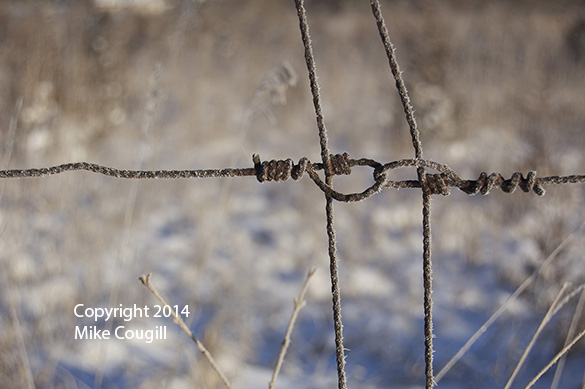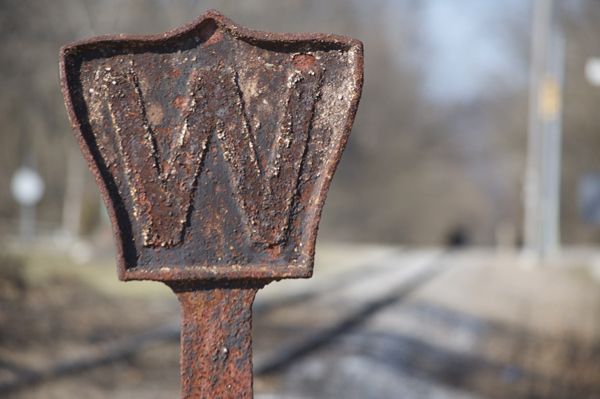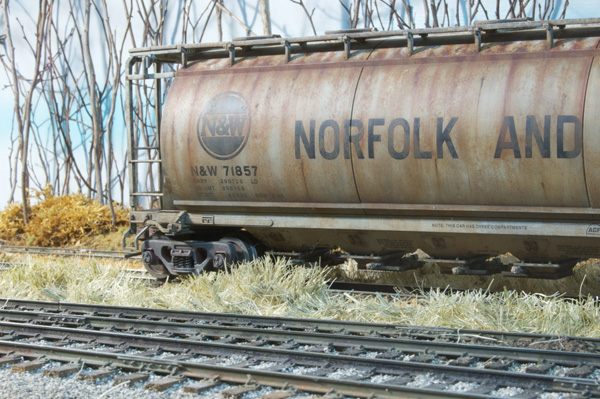From his book, Letting Go Of The Camera, photographer Brooks Jensen shared the insight that we are predisposed to see the world from a certain viewpoint.
What is Your Natural Vision?
In my own photography, I’m drawn to small details seen from a close-up viewpoint as in this photo from last year.
There’s a point of view expressed in these photos via a visual language that I’m comfortable with. Exploring the landscape, camera in hand, I invariably find tiny details like this splice in a woven wire fence or a whistle post on the I&O branch. Shooting close-up throws the background into an abstract pattern of shapes that allows these foreground objects to stand out boldly. The rusted texture of the fence, enhanced by the heavy frost, and the metal post is also a strong related theme. All of these elements are part of the visual language I use to interpret the world. My photos from a mid-range or panoramic viewpoint, while competent, aren’t nearly so powerful.
Reflecting on this after reading Brooks’ essay, What Is Your Natural Vision?, from the book, I understood how this visual theme has run through my creative life in many ways. Consistently, I’ve found ways to get up close to things, to see and understand objects intimately, while ignoring the larger surroundings.
This way of seeing has held firm in how I express the hobby. In years past, I would embark on some grand layout design only to go stale after a short period. I would repeat a predictable pattern of zeroing in on a small and favored scene, bringing it to a high degree of finish, only to loose all interest in the rest.
At the time I didn’t understand this behavior, thinking myself lazy or an undisciplined dilettante who couldn’t stay with anything. Eventually I decided to reduce the width of my layouts from the standard two-foot depth to sixteen inches and felt a sense of relief because I didn’t have to deal with those eight inches of depth anymore. Once that epiphany occurred, my layout designs started getting progressively smaller and simpler. This reduction in size over the years provided more satisfaction because without understanding it consciously, I was bringing my natural way of seeing things to my modeling in a more deliberate manner.
Changing scales from HO to quarter-inch allowed me to visually move in closer, due to the increased size of the models and layout features. Rather than think of having less layout as a negative factor like the hobby mindset suggests, I found a sense of satisfaction, as I could not only model more intimate details, I could also see them from a viewpoint that seemed natural.
How Do You See The World?
You have a natural way of seeing the world, whether you consider yourself creative or not. Mine is a close-up viewpoint that revels in small details, patterns and texture across many subjects. After forty years, I’ve learned how consistent these themes are in our lives and I also know how little awareness people have about such things.
Brooks’ essay suggests that understanding our preferred way of seeing the world provides a greater focus in our work. Understanding brings the power of clarity to our vision and, in time, we become a specialist in our own visual language. In all this, I see a parallel application to our craft.
The Implications Are Immense.
The craft of railroad modeling is as creative as any other art form and the more we understand our predisposed way of seeing, the deeper and more satisfying our efforts will become.
As Brooks observed, it isn’t about the tools, categories or even subject matter. What’s important is how you see, what you see, and what you say when you see.
What if we stopped defining ourselves by our tools, subject matter or medium (I’m an O scaler, I’m a steam era guy, I’m a freight car modeler, I’m an operations guy) and instead, shared how our work reflects the way we see railroading. How would that starting point reshape our narrative about the craft? For example:
“I’m an observer of small details and textures in both objects and the landscape. Railroad modeling is a way for me to explore these details via close study and craftsmanship.”
While the familiar terms speak to us, there is a shallowness in what they communicate. I’m more than the tools, the subject matter or the modeling scale I choose to work with. When you learn that I’m an observer of small details, you have a context for understanding my modeling as a whole, and what I’m trying to say about these things.
From the discussion and the comments of my last post, how many people are building a layout they have no interest in because they’re following another’s vision rather than exploring their own? How many have fallen in love with an idea because convention says that’s how it’s supposed to be done?
Understanding that you are predisposed to see things in a certain way may or may not impact your decisions or subject matter, but it is important knowledge that can make your choices stronger.
Over time I worked my way past the hobby conventions and learned to specialize in my preferred way of seeing things. A smaller, simpler layout design in a large scale, provides a gratifying close-up focus to the work and I know when I’m wandering into areas less satisfying, or that might demand more thoughtful attention on my part. As with any creative endeavor, the tools matter far less than the vision we craft with them.
What about you? How do you see railroading? What do you see in it? What do you want to say about that?
Regards,
Mike



Fascinating post, Mike.
I have frequently said to people (in person, as well as online) that the scale they model in should be secondary to the decision about what they to model. I now realise why – and that in many ways scale is not only secondary to subject, but driven by that. You have also provided me with a better way of framing that opinion (or point of view!)
This also links into Trevor’s “Breaking Marley’s Chains”post on his Port Rowan blog – it was via his blog that I found the link to your blog. Trevor also wrote a fuller article for the Layout Design SIG Journal, which is available on the S Scale SIG website, including as a PDF. Anyone interested in your blog post will enjoy reading Trevor’s article, if they haven’t already read it!
I like Wednesdays: always something to make me think.
Simon
Mike,
Where to begin? First of all thanks for the link to Brooks Jenson’s book. It reminds me of the much thumbed copy of Berger’s “Another Way of Telling” that as a teenager massively influenced my view of what photography could and should do.
You might have inadvertently recreated a very subtle version of the infamous “It is my railway and I’ll decide the rules” argument.
We all see things through lenses. It is difficult to objectively argue which lenses are of most value. What is true though is that two people viewing the same reality through different lenses will interpret things very differently. I’m sure for some people the sense of reality is less dependent on the scenery than on the adherence with prototypical operating practices.whereas for others the exact opposite is true, and some of us would like to see a mix of both.
I can understand your view that narrow layouts in conjunction with a larger scale, works for you, but living in a country where 1ft wide layouts are a norm I can see the enhanced realism that width can bring. It is hard to relate now the impact that Barry Norman’s ‘Petherick had when first exhibited, for instance.
The best layouts, perhaps, are those that either get others to see the world through the same lens, or that balance the different perspectives.
James
You might have inadvertently recreated a very subtle version of the infamous “It is my railway and I’ll decide the rules” argument.
That puts me in mind of George Bernard Shaw’s maxim, “Do not do unto others as you would wish them to do unto you: their tastes may be different”. I have no problem with “Rule 1” as some call it, providing that I can at least know what the “rules” are; they aren’t really rules at all, but the viewpoint which lets everyone know what is driving the modeller to create his layout/vision.
I think Mike has touched on something which goes to the core of getting the maximum reward out of the hobby: know what drives you. And if you don’t, how can you expect others to see the layout through your eyes?
Petherick succeeded because Barry knew what he wanted to achieve. If you read his account of Lydham Heath in MRJ, he begins by stating his inspiration, then talks less about the how, and more about the why. Groundbreaking stuff 21 years ago, a little more commonplace now.
Have to say, Jim, that despite putting several years time and effort into supporting the UK exhibition circuit, I would not say that 1′ wide layouts are the norm: far from it as there is as much variety in width as there is in every aspect of the hobby, although admittedly very few go for a depth of five feet.
Simon
Hi James,
You may have missed my point, or perhaps I didn’t make it as clearly as I could have. I’m absolutely not speaking of, or seeking to impose “rules” in any way. I’m conveying how influential our predisposed manner of seeing the world is.
After I realized how consistently I preferred to look at things close-up, I had a clearer understanding of why I would only go so far with former layouts before abandoning the thing. They were simply too big. I was subconsciously saying: “this is all the layout I really want,” and feeling horribly conflicted because I still bought the “basement empire” dream hook, line and sinker.
My preference for a quite narrow layout depth evolved over time. If one sees the railroad in terms of a sweeping scenic panorama then, the modeled scene will require something deeper in terms of benchwork to accommodate the surrounding scenery. If I wanted to include a deep scene I would have. Indeed, the corner of the layout where the branch curves away from the old mainline is quite deep. So much so that I need to stand on a raised platform to comfortably reach the back of it. And honestly, I hate it.
I know the old “it’s my layout and I’ll do what I want” mantra and that isn’t what I’m talking about at all.
Regards,
Mike
Mike,
My interest in narrow gauge has lead me on a world wide study of how various railroads have interacted with the people and places they serve. Whether it is the Monson railroad moving slate, or the 2ft South African Ry moving apples, they were operated by people, mostly in very rural communities. That is my focus, the interaction of railroad, a community, and a local industry. Why I have decided that modeling one town and the local industry is enough.
Like you, I like the small details, especially since they can tell the story of why and how so well to the viewer.
Matt
Mike,
I think you might have missed the understated British sense of humour in operation,
though that said I think the logical equivalence stands. What is different is the thinking behind it, particularly the reference to other logical rules and tests against external reality.
James
Simon,
We need that reference point of “the others” sometime to counterbalance our inevitable bias. Sometimes a virtual observer helps – How often have we thought something looked fine until we’ve taken a photograph that painfully reveals the flaws of construction?
The flipside of knowing what drives you is knowing what doesn’t, and, if necessary, managing around that. Does that lead us back to the previous blog about the mammoth layout? If we get it wrong we end up with a compromise. When we get it right it actually adds a little magic rather appearing as a compromise.
Perhaps, liek the best works of fiction, layouts succeed when they let us look through the eyes of the author and share their vision
Interesting you mention Lydham Heath because that is one of those odd layouts that should have ticked all my boxes but in the flesh I found it un-involving. That isn’t meant as a criticism of it.
I wasn’t really thinking of 1ft wide layouts from an exhibition perspective so much as those domestic layouts that fight to find space in the typical small post war British dwelling. Having said that of course putting a layout into an exhibition hall can throw out all sorts issues in terms of how the proportions are perceived and lack of control of viewing angles.
James
“I think you might have missed the understated British sense of humour in operation…”
Hi James,
That’s very likely. This form of communication lacks the visual and auditory clues of expression that face-to-face conveys. It’s frightfully easy to misinterpret one another.
Regards,
Mike
Sounds cool Matt. It’s a more holistic and different viewpoint from all the focus on trains and related railroad stuff.
Regards,
Mike